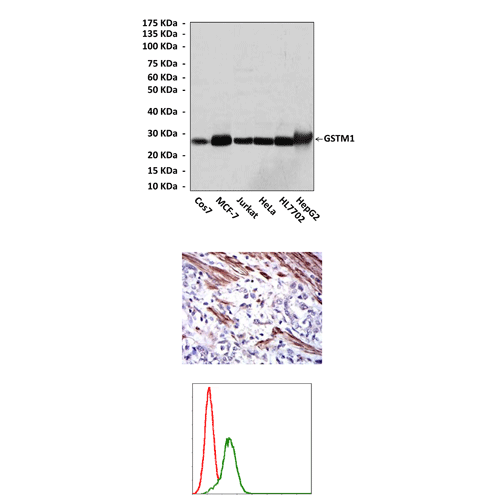Anti-GSTM1: Mouse GSTM1 Antibody |
 |
BACKGROUND Glutathione S-transferase (GST), a major Phase II family of conjugation enzymes, plays a crucial role in the detoxification of drugs and environmental carcinogens. In humans, cytosolic GSTs are divided into eight classes: α (GSTA), µ (GSTM), π (GSTP), θ (GSTT), τ (GSTZ), σ (GSTS), o (GSTO) and κ (GSTK), each of which contains one or more of the homodimeric or heterodimeric isoforms. To date, a total of five µ class genes (M1–M5) situated in tandem on chromosome 1p13.3 have been identified. GSTM1, a member of GSTM family enzymes, detoxifies a number of electrophilic substances, including carcinogens such as polycyclic aromatic hydrocarbons, ethylene oxide, epoxides and styrene. Lack of GSTM1 enzyme may impair metabolic elimination of carcinogenic compounds from the body, thereby increase cancer risk while overexpression of GSTM1 isozyme has been shown to associate with chemotherapeutic resistance. It was shown recently that GSTM1 deficiency enhances ozone-induced IL-8 production, which is mediated by generated ROS and subsequent NF-κB activation in human bronchial epithelial cells.1
GSTM1 is polymorphic in humans. Approximately 50% of individuals in most human populations completely lack the gene and thus the activity of GSTM1. The deletion of the GSTM1 gene seems to be caused by an unequal crossing over event between sequences about 5 kb downstream from GSTM2 and GSTM1, which results in the deletion of the entire GSTM1 gene. The GSTM1 copy number variation (CNV) is in a sense unique. It was shown recently that that ∼60–70% expression from one allele of GSTM1 could suffice for protection against breast cancer; null activity and over activity of GSTM1 are both disadvantageous. These results indicate a U-shaped association of GSTM1 with breast cancer.2
GSTM1 is polymorphic in humans. Approximately 50% of individuals in most human populations completely lack the gene and thus the activity of GSTM1. The deletion of the GSTM1 gene seems to be caused by an unequal crossing over event between sequences about 5 kb downstream from GSTM2 and GSTM1, which results in the deletion of the entire GSTM1 gene. The GSTM1 copy number variation (CNV) is in a sense unique. It was shown recently that that ∼60–70% expression from one allele of GSTM1 could suffice for protection against breast cancer; null activity and over activity of GSTM1 are both disadvantageous. These results indicate a U-shaped association of GSTM1 with breast cancer.2
REFERENCES
1. Wu, W. et al: Free Radical Biol. Med. 51:522-9, 2011
2. Yu, K.-D. et al: FASEB J. 23:2274-87, 2009
2. Yu, K.-D. et al: FASEB J. 23:2274-87, 2009
Products are for research use only. They are not intended for human, animal, or diagnostic applications.
Параметры
Cat.No.: | CP10437 |
Antigen: | Recombinant human GSTM1 fragments expressed in E. coli. |
Isotype: | Mouse IgG1 |
Species & predicted species cross- reactivity ( ): | Human, Mouse, Rat |
Applications & Suggested starting dilutions:* | WB 1:1000 IP n/d IHC 1:50 - 1:200 ICC n/d FACS 1:50 - 1:200 |
Predicted Molecular Weight of protein: | 28 kDa |
Specificity/Sensitivity: | Detects GSTM1 proteins in various cell lysate. |
Storage: | Store at -20°C, 4°C for frequent use. Avoid repeated freeze-thaw cycles. |
*Optimal working dilutions must be determined by end user.
Документы
Информация представлена исключительно в ознакомительных целях и ни при каких условиях не является публичной офертой








